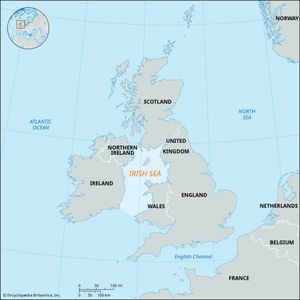Irish Sea
- Irish:
- Muir Éireann
News •
Irish Sea, arm of the North Atlantic Ocean that separates Ireland from Great Britain. The Irish Sea is bounded by Scotland on the north, England on the east, Wales on the south, and Ireland on the west. The sea is connected with the Atlantic by the North Channel between Northern Ireland and Scotland and by St. George’s Channel between the southeastern tip of Ireland and southwestern Wales. The sea is about 130 miles (210 km) long and 150 miles (240 km) wide. Its total area is approximately 40,000 square miles (100,000 square km). Its greatest depth measures about 576 feet (175 m) at the Mull of Galloway, near the sea’s junction with the North Channel. In classical times the Irish Sea was known as Oceanus Hibernicus.
There are two principal islands in the Irish Sea. The Isle of Man lies in the centre of the northern part, and Anglesey lies close to the coast of North Wales. Geologic studies seem to indicate that the Irish Sea originated by rifting during the Paleogene and Neogene periods (about 65 to 2.6 million years ago), and subsidence of its basins was probably initiated or renewed at that time.
Surface tidal currents reach a speed of more than 4 knots in St. George’s Channel, near the Irish coast, and are locally strong elsewhere. Currents are weakest in the west-central Irish Sea. The greatest ranges of tide occur on the northwest English coast. Tidal streams enter the Irish Sea from both the north and the south, meeting near latitude 54° N, just south of the Isle of Man.

On the sea’s eastern shores, Liverpool is the largest British port; Manchester is joined to the Irish Sea by the Manchester Ship Canal. On the west, Dublin, with extensive quays on the River Liffey, handles much of the cargo trade of the Republic of Ireland. Herring and whiting are fished, and there is some trawling for cod and flatfish. Fleetwood, lying north of Liverpool, is the chief British fishing port, and Ardglass, Portavogie, and Kilkeel are important in Northern Ireland. Dun Laoghaire, Howth, Skerries, and Mornington—all near Dublin—are important fishing ports for the Republic of Ireland.

















